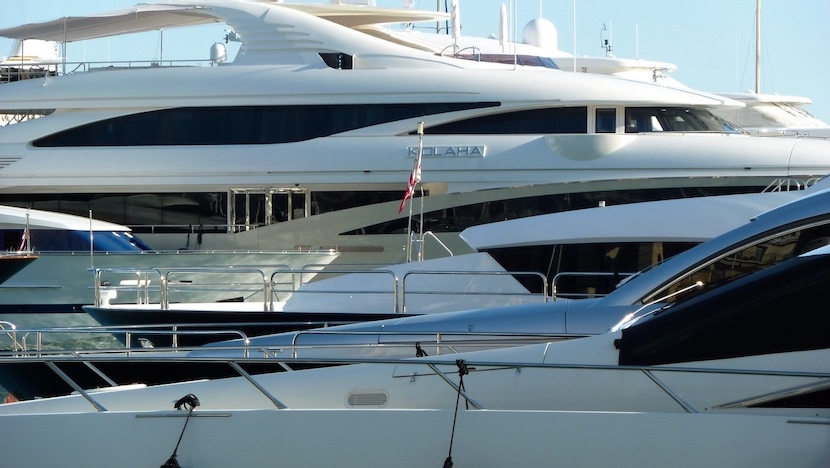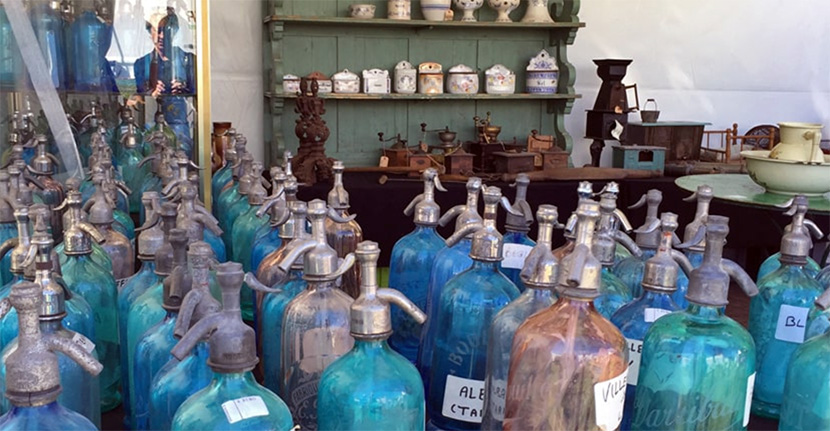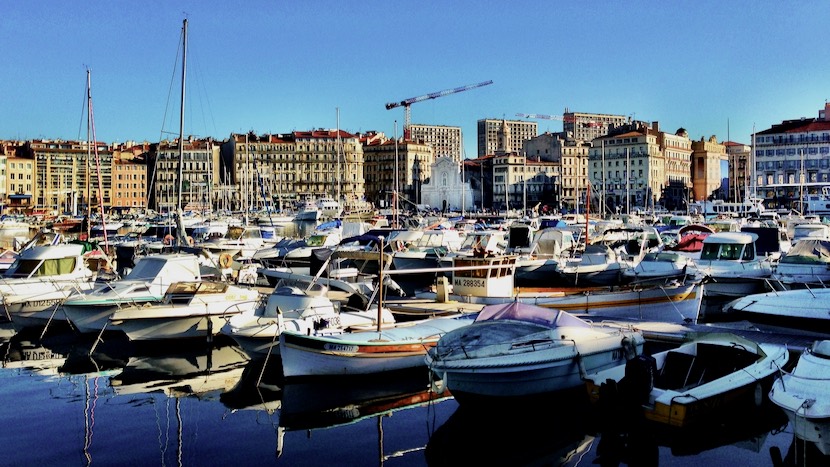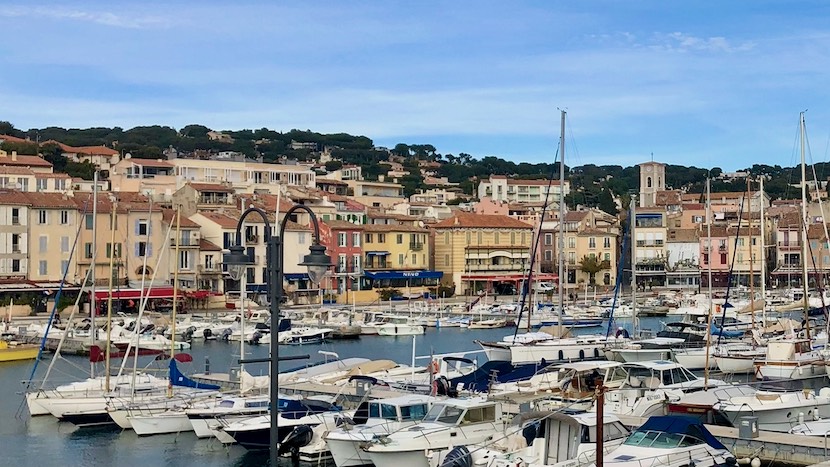
Day Trips From Aix-en-Provence
Did you know that Aix-en-Provence is situated only a couple hours drive from the southern Alps and about ½-hour from the Mediterranean?
Saint-Tropez
Within 2½-hours, you can be on the French Riviera in Saint-Tropez, around a 2-hour drive from Aix-en-Provence. Note that the travel time can vary depending on the traffic congestion getting into the stylish seaside port, and during peak tourist season can take up to an hour longer.
The best way to get from Aix-en-Provence to Saint-Tropez is by car, as there is no train or bus service between the two. For much of the drive you’ll be on large autoroutes (freeways), which are tolled so have either coins or a chip credit card ready because the electronic booths don’t accept paper money or card pins. As you get closer to Saint-Tropez, you’ll take winding local roads (not tolled), passing through stunning scenery and quaint neighboring villages.
The glamorous seaside village dates back to ancient times, and has played an important role in the cultural and economic development of the region. In the early days, Saint-Tropez was a small fishing village and a popular trading port for the Romans.
Over the centuries, it became an important stopover for sailors, fishermen, and merchants traveling between Italy, Spain, and North Africa. In the 19th century, Saint-Tropez began to attract artists, writers, and intellectuals, who were drawn to its natural beauty and relaxed atmosphere.
More recently, it has gained worldwide fame as a glamorous playground for the rich and famous. The town has became synonymous with luxury and excess, super yachts, designer boutiques, and high-end restaurants filling the streets. Yet the town has managed to preserve its traditional charm, and remains a popular destination for all vacationers seeking a taste of the good life on the French Riviera.

L’Isle sur la Sorgue
Interested in antiques and expansive outdoor markets? Then L’Isle sur la Sorgue is definitely a must-see day trip that is less that an hour drive from Aix-en-Provence. Situated on the Sorgue river about 25km southeast of Avignon, it’s aptly nicknamed the “Venice of Provence” because of how the town has evolved over the centuries to nestle against the edges of the intertwining waterways punctuated by charming waterwheels. Yet it’s most famous for its antique shops and Sunday market that originated in the 16th-century.
L’Isle sur la Sorgue is about an hour drive from Aix-en-Provence in the Vaucluse region. When you arrive, expect parking to be a bit of a challenge due to the large number of other antique enthusiasts who will likely be joining you, but once you’re in town you’ll be treated to more than 300 stalls filled with unique items that are sure to please even the most discerning of collectors.
Originally called Insula, L’Isle-sur-la-Sorgue took its current name in the late 19th-century. However, settlement of this area dates as far back as around 4000BC during the Neolithic period. The city began to take its present shape in the 11th-century AD as fishing, oil, wheat, silk, paper, and rugs became the primary industries for early inhabitants. L’Isle-sur-la-Sorgue was (and still is) considered an arrondissement of Avignon, and during the 14th-century was under the direct influence of the Avignon Papacy and the seven Popes who reigned there before the official papal seat returned to Rome.
The city was ransacked and set on fire during the French Revolution, and later transformed economically by the hydraulic energy captured by its waterwheels, which now are mostly gone although a few purely decorative ones do remain as reminders of the past. Today the primary industry is tourism, attracting visitors from around France and the world. If your itinerary allows, I highly recommend a day trip visit to L’Isle sur la Sorgue during your stay in Aix-en-Provence.
Marseille
Marseille is the second largest city in France by population (nestled between number one Paris and number three Lyon) with more than 870k residents. Situated just 32km (20-miles) to the south of Aix-en-Provence, this administrative and commercial capital of the Provence Alpes Côte d’Azur region is well worth a visit if your itinerary allows.

So much so that Time Magazine included this “Mediterranean darling” in its 50 World’s Greatest Places 2022. Low-cost trains run regularly from the Aix-en-Provence station and buses also depart several times an hour, making for easy day trip commute options.
Unless you’re brave, I don’t suggest driving your rental car as the streets can be a challenge to navigate and parking needlessly expensive. Instead, you can take either a bus or train from Aix to the Gare de Marseille-Saint-Charles station, and it’s just a short walk from there to the scenic Vieux Port, shopping areas, and restaurants. As with any large metropolitan city, some parts of Marseille can be a little sketchy, and its gritty reputation for edginess and unseen-but-there mafia activity is not completely undeserved. But if you stay to the tourist areas (see my suggestions below) they’re well-trafficked, very safe, and you’ll have an enjoyable day!
This soulful Mediterranean port city has an independent spirit that dates back over 2,500 years to around 600BC when it was established by seafaring Greek traders from Phocaea, aligning with the Romans a couple of centuries later yet maintaining its sovereignty until the Siege of Massilia in 49 BC when it was absorbed into the Roman Empire.
Massalia, as it was known then, prospered as a maritime hub while also becoming an early center of Christianity until it fell to the Visigoths in the 5th century AD and spiraled into decline until the 10th century when it became part of the County of Provence and once again flourished. Alas, an arrival of a trading ship carrying the bubonic plague from the east in the 14th century put an end to that – half the population (80,000) ultimately perished.
The city’s fate once again rebounded during the mid-15th century under the rule of René of Anjou, Count of Provence, up until the Great Plague of Marseille in 1720. Although the epidemic lasted only a couple of years, it would take nearly a half-century for the economy to fully recover. At the end of the 18th century, Marseille became a center of activity in the French Revolution and the birthplace of France’s national anthem, La Marseillaise.
The Industrial Revolution and establishment of the French Empire during the 19th century propelled further expansion of the city. In 2013, a series of architectural and infrastructure improvements were completed in advance of Marseille-Provence being celebrated as the European Capital of Culture.
Great Day Trips from Aix are Abundant!
Aix is great for fun day trips any time of year, no matter whether they involve ski parkas or suntan oil.
Another of my favorites is Cassis, where you can walk the town, have a terrific seafood lunch in the marina, hike a nearby calanque, and enjoy a wine tasting at one of the scenic domains all in the same day.

With so many options, it’s less a matter of what vibrant places can you see and enjoy, and more how can you choose?
Driving Suggestions for Day Trips
Have plenty of change (coins) or a credit card with the electronic chip handy on your outing. France tolls the major roadways, and only coins or contactless card payments are accepted at the electronic peages (toll booths). If you have paper money or are expecting to enter a pin with your card payment, you’ll find yourself with some annoyed drivers in line behind you as you try to get it sorted out.
There’s a speaker that you can use to contact someone if you get stuck, and it’s likely they will speak at least enough English to communicate if needed. Don’t worry, it’s easy when you’re prepared and you‘ll quickly get the hang of it, because no matter which direction you go you’ll pause frequently to make a donation.
